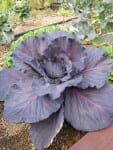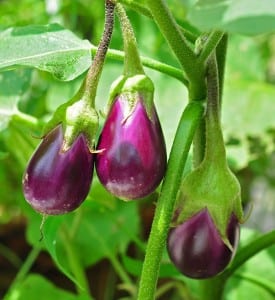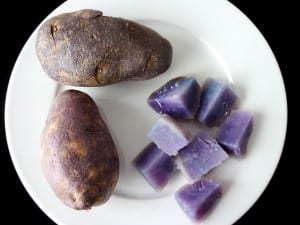 From potatoes to corn, beets to asparagus, you might be noticing some changes to your favorite vegetables these days – because it’s peak purple produce season. Cathy Isom tells us why we may be seeing more purple these days in the produce aisle. That’s coming up on This Land of Ours.
From potatoes to corn, beets to asparagus, you might be noticing some changes to your favorite vegetables these days – because it’s peak purple produce season. Cathy Isom tells us why we may be seeing more purple these days in the produce aisle. That’s coming up on This Land of Ours.
Purple Produce
From: Detroit News.com
Pile on the purple produce
Beyond the mere beauty of purple produce, such as blueberries, blackberries, plums, purple potatoes and eggplant, lies a nutrient-packed, health-protective profile.
 Purple fruits and vegetables can thank the presence of powerful phytochemicals — namely anthocyanins — for their royal purple hue and antioxidant and anti-inflammatory action. Other phytochemicals may be present, too, including resveratrol and ellagic acid, as well as powerful nutrients like vitamin C and fiber. In fact, people who eat purple fruits and vegetables have higher intakes of essential nutrients, such as fiber, potassium and vitamin C, according to a 2011 study published in the American Journal of Lifestyle Medicine, which examined dietary intakes of 15,000 children and adults.
Purple fruits and vegetables can thank the presence of powerful phytochemicals — namely anthocyanins — for their royal purple hue and antioxidant and anti-inflammatory action. Other phytochemicals may be present, too, including resveratrol and ellagic acid, as well as powerful nutrients like vitamin C and fiber. In fact, people who eat purple fruits and vegetables have higher intakes of essential nutrients, such as fiber, potassium and vitamin C, according to a 2011 study published in the American Journal of Lifestyle Medicine, which examined dietary intakes of 15,000 children and adults.
Studies show that anthocyanin-rich purple fruits and vegetables have numerous health benefits. Eating purple produce may help reduce the risks of certain types of cancer and heart disease, and aid in immune, eye, brain and digestive health.
Adults who consume purple produce regularly have significantly lower waist circumferences and body mass indexes than those who do not consume purple produce (American Journal of Lifestyle Medicine, 2011). And two daily servings of steamed purple potatoes significantly lowered blood pressure by about four percent, according to a 2011 study from the University of Scranton.
Beyond your grocery staples, such as blueberries and cabbage, a cornucopia of purple-hued produce is now available at farmers markets, grocery stores and restaurants.
Eggplant Salad
1 large eggplant, split lengthwise
4 tablespoons olive oil, divided
1 large clove garlic
1/4 teaspoon coarse sea salt
1/2 lemon, juice and zest
Black pepper, to taste
Preheat oven to 400 degrees.
Rub the eggplant with half of the olive oil. Place, cut side down, on a baking sheet and roast in the oven for 20 to 25 minutes. Remove from oven, and cool slightly.
Scoop the eggplant flesh into a medium bowl and whisk with a fork until smooth.
Mash garlic and salt together to form a paste.
Mix in lemon juice and zest, black pepper, and remaining olive oil.
Serve with whole grain pita or bread. Serves 8.
Per serving: 80 calories; 7 g fat (1 g saturated fat; 78 percent calories from fat); 4 g carbohydrates; 3 g sugar; 0 mg cholesterol; 290 mg sodium; 1 g protein; 2 g fiber.
Nutrition Information Per Serving: 80 calories, 1 g protein, 4 g carbohydrate, 3 g sugar, 7 g fat, 1 g saturated fat, 2 g fiber, 290 mg sodium.
From: Eating Well.com
Nutrition and Health Benefits of Purple Potatoes & More Purple Produce
By Gretel H. Schueller, “Purple Reigns”
Find out how purple sweet potatoes, purple cauliflower, purple cabbage and more foods can help fight disease.
“Only humans and birds have color vision,” notes David Heber, director of UCLA’s Center for Human Nutrition. He believes the ability to see color probably evolved as a way for us to better see—and eat—the bounty of colorful fruits and veggies. Lucky us!
Colors don’t just make food pretty: they’re a sign of nutritional power. And purple is mighty. This royal shade comes from anthocyanins—disease-fighting antioxidants. The pigment produces red, blue and violet foods, depending on the type of anthocyanin (there are hundreds).
 “The deeper the red-purple, the higher the anthocyanin concentration,” explains Heber, author of What Color Is Your Diet? Purple potatoes, for example, have antioxidant levels equal to kale and spinach. There’s plenty of evidence to support the power of purple: Research on anthocyanins indicates they may be effective in preventing certain cancers, reducing the risk of heart disease and Parkinson’s and improving eyesight. According to a study at the University of Scranton in Pennsylvania, a group of obese people with high blood pressure eating two servings of steamed purple potatoes a day significantly lowered their blood pressure by about 4 percent (6 points) after a month—making those potatoes almost as effective as oatmeal.
“The deeper the red-purple, the higher the anthocyanin concentration,” explains Heber, author of What Color Is Your Diet? Purple potatoes, for example, have antioxidant levels equal to kale and spinach. There’s plenty of evidence to support the power of purple: Research on anthocyanins indicates they may be effective in preventing certain cancers, reducing the risk of heart disease and Parkinson’s and improving eyesight. According to a study at the University of Scranton in Pennsylvania, a group of obese people with high blood pressure eating two servings of steamed purple potatoes a day significantly lowered their blood pressure by about 4 percent (6 points) after a month—making those potatoes almost as effective as oatmeal.
Beyond grocery staples like red cabbage, plums and eggplants, a cornucopia of indigo-hued produce is now available, including purple asparagus, baby artichokes, Brussels sprouts, carrots, cauliflower, kohlrabi, peppers, potatoes, tomatoes and wax beans—making it easier than ever to color your diet healthy.
Image credits: (top left) Red Cabbage: By I, KENPEI, CC BY-SA 3.0, https://commons.wikimedia.org/w/index.php?curid=3622947
(middle right) Eggplant: By Joydeep, CC BY-SA 3.0, https://commons.wikimedia.org/w/index.php?curid=20825279
(lower left) Blue Suede Potato: By Paebi – Own work, CC BY-SA 3.0, https://commons.wikimedia.org/w/index.php?curid=9736436









